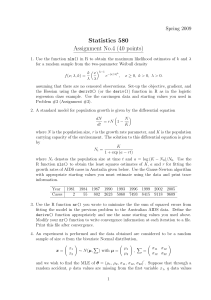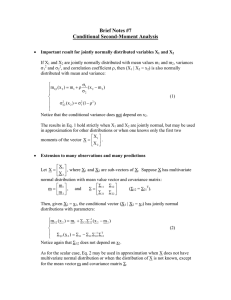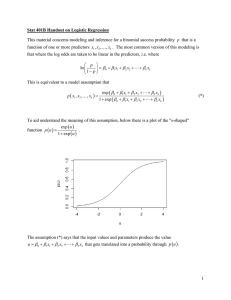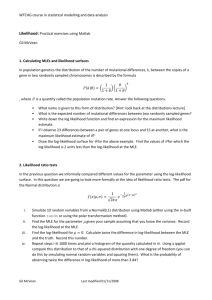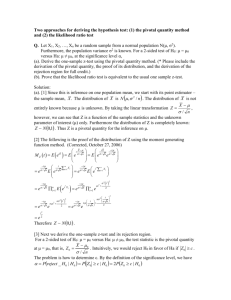Stat 700 HW 7 Solutions, F'09
advertisement
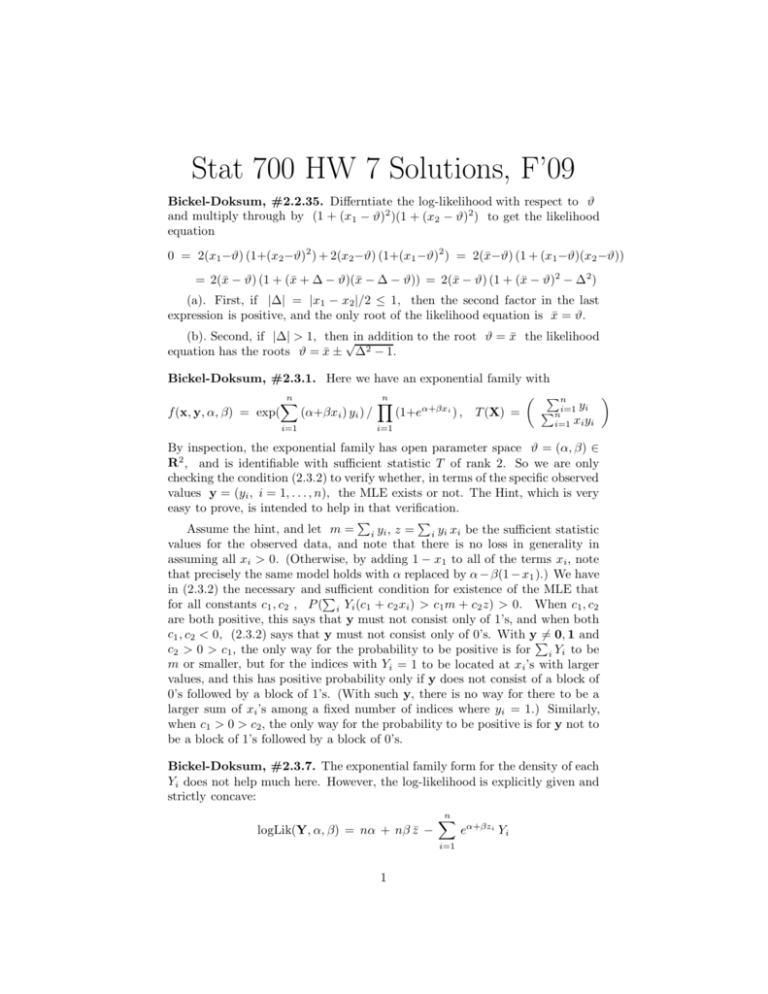
Stat 700 HW 7 Solutions, F’09
Bickel-Doksum, #2.2.35. Differntiate the log-likelihood with respect to ϑ
and multiply through by (1 + (x1 − ϑ)2 )(1 + (x2 − ϑ)2) to get the likelihood
equation
0 = 2(x1−ϑ) (1+(x2−ϑ)2 ) + 2(x2−ϑ) (1+(x1 −ϑ)2 ) = 2(x̄−ϑ) (1 + (x1−ϑ)(x2 −ϑ))
= 2(x̄ − ϑ) (1 + (x̄ + ∆ − ϑ)(x̄ − ∆ − ϑ)) = 2(x̄ − ϑ) (1 + (x̄ − ϑ)2 − ∆2)
(a). First, if |∆| = |x1 − x2|/2 ≤ 1, then the second factor in the last
expression is positive, and the only root of the likelihood equation is x̄ = ϑ.
(b). Second, if |∆| > 1, then√in addition to the root ϑ = x̄ the likelihood
equation has the roots ϑ = x̄ ± ∆2 − 1.
Bickel-Doksum, #2.3.1. Here we have an exponential family with
Pn
n
n
X
Y
Pni=1 yi
f(x, y, α, β) = exp(
(α+βxi ) yi ) /
(1+eα+βxi ) , T (X) =
i=1 xi yi
i=1
i=1
By inspection, the exponential family has open parameter space ϑ = (α, β) ∈
R2 , and is identifiable with sufficient statistic T of rank 2. So we are only
checking the condition (2.3.2) to verify whether, in terms of the specific observed
values y = (yi , i = 1, . . . , n), the MLE exists or not. The Hint, which is very
easy to prove, is intended to help in that verification.
P
P
Assume the hint, and let m = i yi , z = i yi xi be the sufficient statistic
values for the observed data, and note that there is no loss in generality in
assuming all xi > 0. (Otherwise, by adding 1 − x1 to all of the terms xi, note
that precisely the same model holds with α replaced by α − β(1 − x1 ).) We have
in (2.3.2) the necessary and P
sufficient condition for existence of the MLE that
for all constants c1 , c2 , P ( i Yi (c1 + c2 xi) > c1m + c2 z) > 0. When c1, c2
are both positive, this says that y must not consist only of 1’s, and when both
c1 , c2 < 0, (2.3.2) says that y must not consist only of 0’s. With yP
6= 0, 1 and
c2 > 0 > c1, the only way for the probability to be positive is for i Yi to be
m or smaller, but for the indices with Yi = 1 to be located at xi’s with larger
values, and this has positive probability only if y does not consist of a block of
0’s followed by a block of 1’s. (With such y, there is no way for there to be a
larger sum of xi’s among a fixed number of indices where yi = 1.) Similarly,
when c1 > 0 > c2, the only way for the probability to be positive is for y not to
be a block of 1’s followed by a block of 0’s.
Bickel-Doksum, #2.3.7. The exponential family form for the density of each
Yi does not help much here. However, the log-likelihood is explicitly given and
strictly concave:
logLik(Y, α, β) = nα + nβ z̄ −
n
X
i=1
1
eα+βzi Yi
Concavity implies that the unique MLE can be found as the solution of the
likelihood equations defined by setting partial derivatives equal to 0. The two
equations are
n =
n
X
eα+βzi Yi
,
n z̄ =
i=1
n
X
eα+βzi zi Yi
i=1
These two equations can be written equivalently as:
n
X
(zi − z̄) Yi eβ(zi −z̄) = 0 ,
eα = n/
i=1
n
X
Yi eβzi
i=1
The first of these equations has a solution by the intermediate value theorem,
since as β → −∞, the left-hand side converges to − ∞, while as β → ∞,
the left-hand side converges to + ∞. In terms of
Pnthe solution β̂ of the
first equation, α̂ is evidently determined as log(n/ i=1 Yi exp(β̂zi )). Strict
concavity of the log-likelihood implies the solution (α̂, β̂) determined in this
way is unique.
Bickel-Doksum, #2.4.4. (a). First,
fX (j, y) = λ
· exp
−
P
ji
(1 − λ)
P
(1−ji )
−
(2π)−n/2 σ1
P
ji
−
σ0
P
(1−ji )
·
n
n
1 X
1 X
ji (yi − µ)2 −
(1 − ji ) (yi − µ)2
2
2
2σ1 i=1
2σ0 i=1
which by inspection gives the sufficient statistics
n
n
1 X
1 X
Y
I
+
Yi (1 − Ii )
i
i
σ12 i=1
σ12 i=1
X
Ii
for
log
for
µ
λ
µ2
µ2
−
2 +
1−λ
2σ1
2σ02
(b). These sufficient statistics are minimal because complete and rank 2
(i.e., parameters are identifiable in open region).
P
(c). For ML, solve λ̂ = i Ii /n and
0 =
1 X
1 X
Ii (Yi − µ̂) + 2
(1 − Ii )(Yi − µ̂)
2
σ1 i
σ0 i
which implies the existence of MLE always:
X
X
X
X
µ̂ =
Ii Yi /σ12 +
(1 − Ii )Yi /σ02 /
Ii /σ12 +
(1 − Ii )/σ02
i
i
i
i
Bickel-Doksum, #2.4.9. In this problem, X = (U, V, W ) is a discrete
random variable with values in {1, . . ., A} × {1, . . . , B} × {1, . . . , C}. The cell
2
probabilities are pabc = P (X = (a, b, c)) = P (U = a, V = b, W = c). First, if
log pabc = µac + νbc, then
P (U = a, V = b|W = c) = pabc /
A
B
X
X
pj,k,c = exp(µac +νbc)/
eµjc
eνkc
X
j=1
j,k
k=1
eµac
eνbc
= PA
· PB
= P (U = a|W = c) · P (V = b|W = c)
µjc
νkc
j=1 e
k=1 e
For the converse, if we assume that pabc /P (W = c) factors as in the final
expression into a function P (U = a|W = c) depending only on (a, c) and
another function P (V = b|W = c) dependeing only on (b, c), then define
µac = log(P (U = a, W = c)), νbc = log(P (V = b|W = c)), making pabc =
exp(µac + νbc).
Pn
(b) Let Nabc denote the count
i=1 I[Ui = a, Vi = b, Wi = c], and
use subscript +’s to denote summation over unwanted indices, e.g., Na+c =
PB
Pn
family form
b=1 Nabc =
i=1 I[Ui =a, Wi =c] . Then we obtain the exponential
Qn
of the data X1 , . . ., Xn by expressing the likelihood as
p
U
V
i i Wi =
i=1
exp
n
X
(µUi Wi + νViWi )
= exp
C
A X
X
Na+c µac +
a=1 c=1
i=1
C
B X
X
N+bc νbc
b=1 c=1
From this, we can see that the statistics {Na+c , N+bc : a = 1, . . ., A, b =
1, . . . , B, c = 1, . . . , C} are sufficient. But to reduce these to a minimal set, we
remove the linear degeneracies by defining the sufficient statistics as
{N++c , c = 1, . . . , C − 1} , {Na+c , a = 1, . . ., A − 1, c = 1, . . . , C}
{N+bc , b = 1, . . . , B − 1, c = 1, . . ., C}
These sufficient statistics have no further linear degeneracies, since they have
positive probabilities of taking on any nonnegative integer-value combinations
such that within the first of the three curly-brackets the sum is ≤ n, and
within the second and third the respective sums over a and b are ≤ N++c .
The corresponding parameters are reduced by defining as at the end of part (a):
γc = log P (W = c), µa|c = log P (U = a|W = c), νbc = log P (V = b|W = c)
resulting in the constraints (for all fixed c in the second and third equalities)
C
X
c=1
eγc = 1 ,
A
X
eµa|c = 1 ,
a=1
B
X
eνbc = 1
(∗)
b=1
(c) The maximization could be directly by using Lagrange multipliers, but
using the parameters defined in (b) above, with the constraints γ+ = µ+|c =
ν+c ≡ 0, the log-likelihood becomes
X
X
1
Na+c ( γc + µa|c ) +
N+bc νbc
A
a,c
b,c
3
=
X
N++c γc /A +
c
X
Na+c µa|c +
a,c
X
N+bc νbc
b,c
Maximizing this subject to the constraints (*) is possible if and only if N++c =
0, yielding the equations
N++c /A + λeγc = 0 ∀ c
⇒
λ = −n/A, γ̂c = log(N++c /n)
Na+c + ρc eµa|c = 0 ∀ a, c
⇒
ρc = −N++c , µ̂a|c = log(Na+c /N++c )
N+bc + τc eνbc = 0 ∀ b, c
⇒
τc = −N++c , ν̂bc = log(N+bc /N++c )
Putting these estimates in for the parameters γc , µa|c, νbc immediately leads
to the desired equivalent form p̂abc = Na+c N+bc /(n N++c ).
Bickel-Doksum, #2.4.11. (a) Here Si and ∆i are jointly distributed with
∆i ∼ Binom(1, λ) ,
2
and given ∆i , Si ∼ N (µ2−∆i , σ2−∆
)
i
(The subscript 2 − ∆i is 1 for ∆i = 1 and is 2 for ∆i = 0.
marginal density of Si is, as desired,
Thus the
P (∆) fS|∆ (s|1) + (1−P (∆ = 1)) fS|∆ (s|0) = λ ϕσ1 (s−µ1 ) + (1−λ) ϕσ2 (s−µ2 )
As defined in this problem, the observed data are Xobs = (Si , i = 1, . . ., n),
the missing data are Ymis = (Si , i = 1, . . ., n), and the unknown parameters
are ϑ = (λ, µ1 , µ2 , σ1, σ2).
(b) The joint complete (including missing) data log-likelihood is a constant plus
−
n
1 X h
(Si − µ1 )2 i
∆i − 2 log λ + log σ12 +
2
σ12
i=1
h
(Si − µ2)2 i
+ (1 − ∆i) − 2 log(1 − λ) + log σ22 +
σ22
(†)
To find the E- and M- steps, starting from an initial guess ϑ1 , we must find
p1(Si ) = Pϑ1 (∆i = 1|Si ) =
λ1 ϕσ1,1 (Si − µ1,1)
λ1 ϕσ1,1 (Si − µ1,1) + (1 − λ1 ) ϕσ2,1 (Si − µ2,1)
Then the E-step, conditional expectation under ϑ0 of the complete log-likelihood
(†), gives as a function of ϑ :
−
n
h
1 X
(Si − µ1 )2 i
p1(Si ) − 2 log λ + log σ12 +
2 i=1
σ12
h
(Si − µ2 )2 i
+ (1 − p1 (Si )) − 2 log(1 − λ) + log σ22 +
σ22
4
and the M-step is to maximize this (at next iterative guess ϑ = ϑ2), which is
easily seen to yield:
Pn
Pn
n
1 X
i=1 p1 (Si ) Si
i=1 (1 − p1 (Si )) Si
P
λ̂2 =
p1(Si ) , µ̂1,2 = P
=
,
µ̂
2,2
n
n
n
p
(S
)
1
i
i=1
i=1 (1 − p1 (Si ))
i=1
2
σ̂1,2
=
Pn
i=1
p1(Si ) (Si − µ̂1,2)2
Pn
i=1 p1 (Si )
2
σ̂2,2
,
=
Pn
i=1
(1 − p1(Si )) (Si − µ̂2,2)2
Pn
i=1 (1 − p1 (Si ))
Bickel-Doksum, #3.4.11 (a). The probability mass function for each Yi is
p(k, α, β) =
1 (α+βzi )k
exp(−eα+βzi ) ,
e
k!
k = 0, 1, . . .
This is of exponetial-family form for each i, and the joint probability mass
function for Y = (Y1 , . . . , Yn) is
exp(α
n
X
i=1
yi + β
n
X
yi zi −
i=1
n
X
exp(α + βzi ))
i=1
n
Y
i=1
The sufficient statistic for the natural parameter (α, β) is
1
(yi )!
Pn
i=1
yi (1, zi )0.
(b) I(α, β) is obtained by taking the negative Hessian log-likelihood, which
no longer involves the data:
I(α, β) =
n
X
eα+βzi
i=1
1 ⊗2
zi
(c) The limiting information per observation with zi = log(i/(n + 1)) is
⊗2
Z 1
n
⊗2
1
1 X α i β 1
lim
e
= eα
xβ
dx
log(i/(n + 1))
n n
log x
n+1
0
i=1
and since, by the substitution x = exp(−z), for j = 0, 1, 2
Z
Z ∞
β
j
j
x (log x) dx = (−1)
z j e−(1+β)z dz = (−1)j (j!) (1 + β)−j−1
0
0
we obtain
lim
n
1
1
I(α, β) =
n
1+β
1
−1/(β + 1)
−1/(β + 1)
2/(β + 1)2
The limit on n times the lower bounds of variances of the estimators are the
diagonal elements of the inverse of the last-displaued matrix, which is
2
(β + 1)
a.var = (β + 1)
(β + 1) (β + 1)2
5
